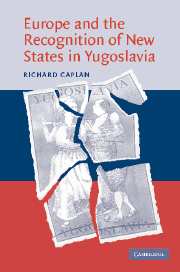Book contents
- Frontmatter
- Contents
- Acknowledgements
- Introduction
- 1 The EC's recognition policy: origins and terms of reference
- 2 Recognition of states: legal thinking and historic practice
- 3 International law, international relations and the recognition of states
- 4 EC recognition of new states in Yugoslavia: the strategic consequences
- 5 Political conditionality and conflict management
- Conclusion
- Appendices
- Bibliography
- Index
1 - The EC's recognition policy: origins and terms of reference
Published online by Cambridge University Press: 22 September 2009
- Frontmatter
- Contents
- Acknowledgements
- Introduction
- 1 The EC's recognition policy: origins and terms of reference
- 2 Recognition of states: legal thinking and historic practice
- 3 International law, international relations and the recognition of states
- 4 EC recognition of new states in Yugoslavia: the strategic consequences
- 5 Political conditionality and conflict management
- Conclusion
- Appendices
- Bibliography
- Index
Summary
The European Community's decision to recognise the republics of Yugoslavia seeking statehood was taken at a Council of Ministers meeting in Brussels on 16 December 1991, six months after the war began following Slovenia's and Croatia's declarations of independence on 25 June 1991. Initial confidence in the EC's capacity for effective mediation in the crisis had by that time been displaced by a conviction among some member states that more radical measures were urgently needed to stop the fighting. A few governments, notably those of Germany and Denmark, had spoken openly about recognising the break-away republics as a means to achieve that goal soon after the outbreak of hostilities, and as the war progressed Germany especially became more outspoken in support of recognition. But because of the importance attached to maintaining political consensus within the Community, persistent objections from other member states – particularly France, Britain and the Netherlands – meant that EC recognition would not be forthcoming until the opposing states finally yielded at the December foreign ministers' meeting.
Numerous accounts have been written about the events leading up to the EC's fateful decision; these events, therefore, are discussed here only briefly. This chapter focuses instead on the content of the EC's recognition policy for what it reveals about thinking within the Community regarding strategies for achieving a peaceful settlement of the Yugoslav conflict.
- Type
- Chapter
- Information
- Europe and the Recognition of New States in Yugoslavia , pp. 15 - 48Publisher: Cambridge University PressPrint publication year: 2005



